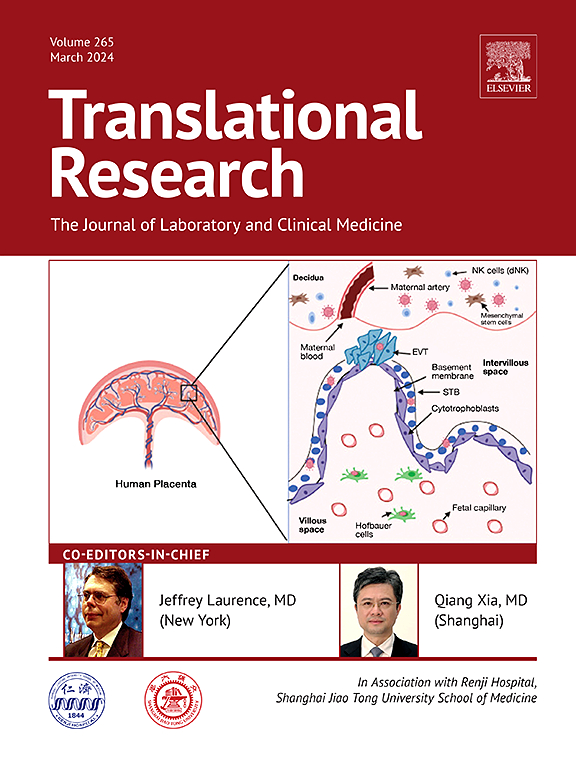Sodium-glucose co-transporter 2 (SGLT-2) inhibitors ameliorate renal ischemia-reperfusion injury (IRI) by modulating autophagic processes
IF 5.9
2区 医学
Q1 MEDICAL LABORATORY TECHNOLOGY
引用次数: 0
Abstract
Renal ischemia-reperfusion injury (IRI) is a common clinical condition that currently lacks effective treatment options. Inhibitors targeting the sodium-glucose co-transporter-2 (SGLT-2), recognized for their role in managing hyperglycemia, have demonstrated efficacy in enhancing the health outcomes for diabetic patients grappling with chronic kidney disease. Nevertheless, the precise impact of SGLT-2 inhibitors on renal ischemia-reperfusion injury (IRI) and the corresponding transcriptomic alterations remain to be elucidated. In our research, we developed a model of IRI using male C57BL/6 mice by clamping the unilateral renal artery and administering empagliflozin Transcriptomic alterations were analyzed using RNA sequencing (RNA-Seq), complemented by proteomic analysis to investigate the effects of empagliflozin. Histological assessments revealed increased renal inflammatory cell infiltration, widespread renal tubular injury, and elevated autophagosomes formation in the IRI group compared to controls. These pathological changes were significantly attenuated following empagliflozin treatment. Besides, renal function impairment can be alleviated in empagliflozin-treated group. RNA-Seq analysis identified lysosomal autophagy as a key biological process in IRI mice. Empagliflozin exerted a renoprotective effect by downregulating lysosome-associated membrane proteins, primarily LAMP1, LAMP2, and LAMP4 (CD68), through the PI3K-Akt, MAPK, and mTOR signaling pathways, thereby inhibiting autophagic processes. In conclusion, this study highlights enhanced inflammation and disrupted metabolism as hallmark transcriptomic signatures of renal. Furthermore, it demonstrates the renoprotective effects of empagliflozin in alleviating renal IRI by modulating autophagic processes.
钠-葡萄糖共转运蛋白2 (SGLT-2)抑制剂通过调节自噬过程改善肾缺血再灌注损伤(IRI)。
肾缺血再灌注损伤(IRI)是一种常见的临床疾病,目前缺乏有效的治疗方案。靶向钠-葡萄糖共转运蛋白-2 (SGLT-2)的抑制剂在控制高血糖中发挥着重要作用,已经证明在改善慢性肾病糖尿病患者的健康结果方面具有疗效。然而,SGLT-2抑制剂对肾缺血再灌注损伤(IRI)的确切影响以及相应的转录组学改变仍有待阐明。在我们的研究中,我们用雄性C57BL/6小鼠建立了IRI模型,通过夹紧单侧肾动脉并给药恩帕列净,利用RNA测序(RNA- seq)分析转录组学变化,辅以蛋白质组学分析来研究恩帕列净的作用。组织学评估显示,与对照组相比,IRI组肾脏炎症细胞浸润增加,肾小管损伤广泛,自噬体形成升高。经恩格列净治疗后,这些病理改变明显减轻。此外,恩格列净治疗组可减轻肾功能损害。RNA-Seq分析发现,溶酶体自噬是IRI小鼠的一个关键生物学过程。Empagliflozin通过PI3K-Akt、MAPK和mTOR信号通路下调溶酶体相关膜蛋白,主要是LAMP1、LAMP2和LAMP4 (CD68),从而抑制自噬过程,从而发挥肾保护作用。总之,本研究强调炎症增强和代谢紊乱是肾脏病变的标志性转录组特征。此外,它还证明了恩格列净通过调节自噬过程减轻肾IRI的肾保护作用。
本文章由计算机程序翻译,如有差异,请以英文原文为准。
求助全文
约1分钟内获得全文
求助全文
来源期刊

Translational Research
医学-医学:内科
CiteScore
15.70
自引率
0.00%
发文量
195
审稿时长
14 days
期刊介绍:
Translational Research (formerly The Journal of Laboratory and Clinical Medicine) delivers original investigations in the broad fields of laboratory, clinical, and public health research. Published monthly since 1915, it keeps readers up-to-date on significant biomedical research from all subspecialties of medicine.
 求助内容:
求助内容: 应助结果提醒方式:
应助结果提醒方式:


